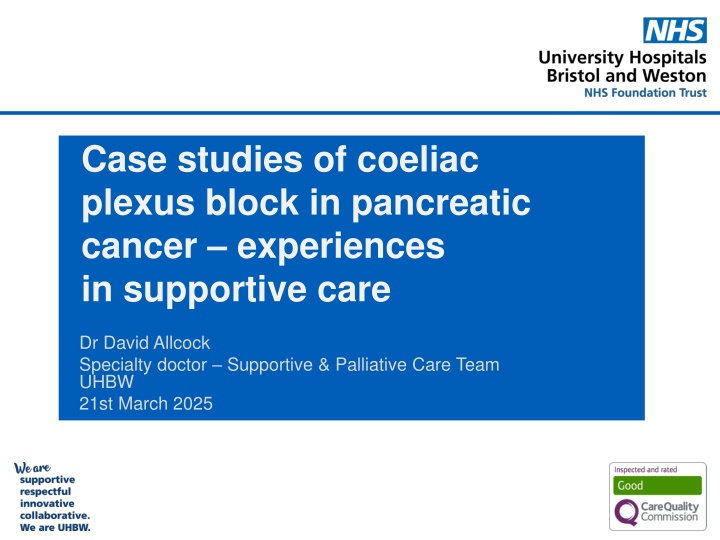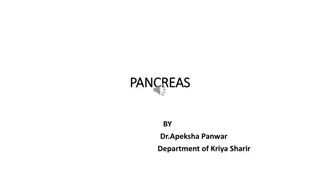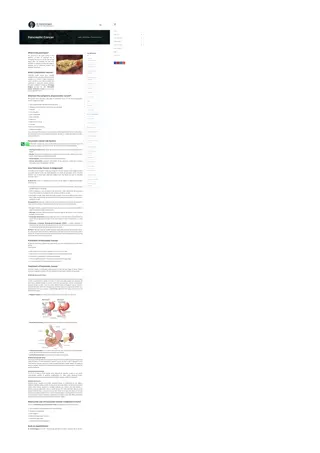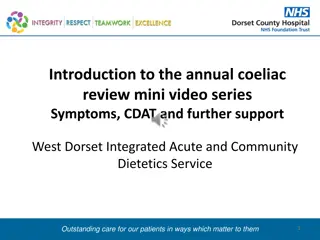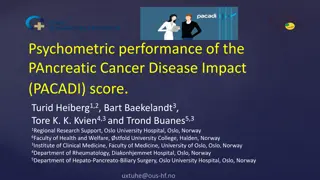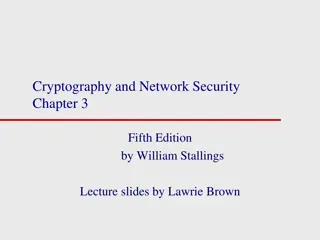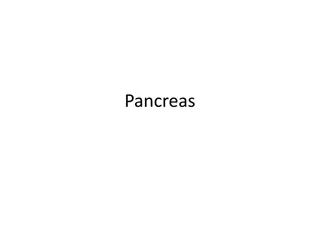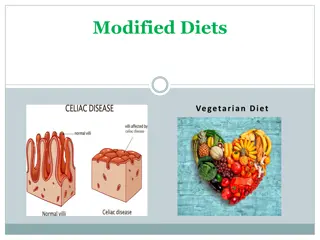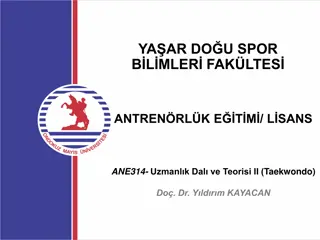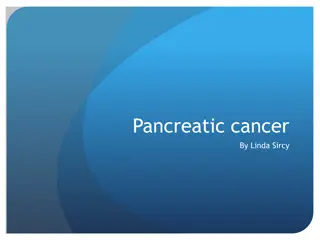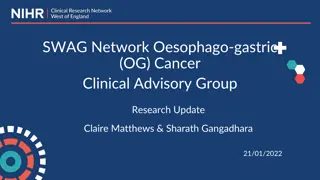Case Studies of Coeliac Plexus Block in Pancreatic Cancer: Experiences in Supportive Care
This article explores the use of coeliac plexus block (CPB) in managing difficult pain in pancreatic cancer patients within a supportive care framework. It delves into the benefits gained by patients who underwent CPB, as well as reasons why some patients did not opt for this procedure. The Enhanced Supportive Care model, specifically the Cancer Enhanced Supportive Care (CESC) service, is highlighted alongside details of two case studies and the supportive care cohort's outcomes.
Download Presentation

Please find below an Image/Link to download the presentation.
The content on the website is provided AS IS for your information and personal use only. It may not be sold, licensed, or shared on other websites without obtaining consent from the author.If you encounter any issues during the download, it is possible that the publisher has removed the file from their server.
You are allowed to download the files provided on this website for personal or commercial use, subject to the condition that they are used lawfully. All files are the property of their respective owners.
The content on the website is provided AS IS for your information and personal use only. It may not be sold, licensed, or shared on other websites without obtaining consent from the author.
E N D
Presentation Transcript
Case studies of coeliac plexus block in pancreatic cancer experiences in supportive care Dr David Allcock Specialty doctor Supportive & Palliative Care Team UHBW 21st March 2025
Aims 1. Brief overview of the principle of 'enhanced supportive care' and the 2023/24 UHBW service pilot (for context) 2. Discuss two case studies of patients with difficult pancreatic cancer pain from our cohort who underwent CP block: When in their cancer treatment journey? Did they gain benefit? 3. And those with difficult pain who didn t have blocks why not? Putting these procedures in clinical context for supportive/palliative care patients with difficult pain
Enhanced Supportive Care Enhanced Supportive Care (ESC) model management of challenging symptoms resulting from an individual s cancer and/or cancer treatment through early multidisciplinary care January 2023 - funded by NHS England - Cancer Enhanced Supportive Care (CESC) service was developed and piloted at UHBW - led by Dr Charlotte Chamberlain (SPCT consultant) Multi-disciplinary service seeing patients with incurable hepato- biliary and upper GI cancers (and later lung) receiving disease- targeted SACT Medic/CNS, OT/PT, dietetic input, Macmillan and hospice services alongside oncologist and site-specific CNS team
The supportive care cohort Our data-set provided opportunity for small retrospective case series of pancreatic cancer patients with difficult pain who had received supportive care input +- CPB 'Difficult pain' - as defined by*: --> significant opioid requirement - oral morphine (OME) of 100mg daily --> and/or patients with pain that required more intensive clinical input at any stage eg. From supportive care or cancer symptoms requiring attendance to oncology SDEC and/or acute hospital admission Upper GI: 30 patients Pancreatic cancer: 46 CESC saw 97 new patients between Apr 23 Nov 23 4 difficult pain* HPB: 51 patients 2 underwent CPBs Lung: 16 patients
Patient who underwent CPB: case one 58 year old male metastatic pancreatic Ca 1st oncology outpatient appointment - PS 2 exclusively due to pain and not fit enough for chemo Referred by oncology for CPB at 1st appt CPB block Jan 2023: Bupivacaine 0.25% 20mL and Triamcinolone 80mL Nov 22 - diagnosis Jan 23 - CPB Jan 24 - RIP
Patient who underwent CPB: case one No improvement in pain with CPB Pain stabilised with hospice input on Zomorph 60mg BD, Oramorph 20mg BD (regularly) and amitriptyline 20mg OME = 160mg Fit enough to complete 8 cycles of chemo Pain remained fairly stable, however - deteriorated with upper GI bleeding - died Jan 2024 Reflection early appropriate referral for block, but unfortunately limited benefit Nov 22 - diagnosis Jan 23 - CPB Jan 24 - RIP
Patient who underwent CPB: case two 52 year old metastatic pancreatic cancer dx Aug 22 Completed chemoradiotherapy Dec 22 but remained unresectable Increasing abdo pain and gut dysfunction July 2023 CESC 'hot clinic' alongside oncology Aug 2023: rapidly worsening pain with disease progression on CT Commenced morphine MR 20mg BD and referred for CPB July 23: increasing pain with Dx progression. Starts MR morphine. Aug to Dec 22: Dx and SACT
Patient who underwent CPB: case two Oct 23: RIP 1/8/23: 1st CP block 17/8/23: 2nd CP block CPB block one 11/8: 0.25% 20mL Bupivicaine and Triamcinolone 80mL - D1: stopped MR morphine and pain score 1-2/10 (from 10) - Following days: 10-50mg Oramorph daily 2nd CPB 17/8: 0.25% 20mL Bupivicaine and Triamcinolone 80mL - Benefit unclear: some improvement in pain, but had also started amitriptyline and was taking higher PRN Oramorph dose - 2 weeks post block: rapidly escalating pain 90mg MR morphine
Patient who underwent CPB: case two At point of d/c from CESC: OME = 240mg (plus pregabalin 50mg BD) Rapid deterioration thereafter died 2/12 later on hospice IPU Reflections: Seemed to gain some temporary benefit from block one should block two have been neurolytic? Role for ITDD? Prognosis too short At point of CPB, patient had very advanced intra- abdominal disease
Two other patients with difficult pain 1) 64 y/o male metastatic pancreatic Ca: Referred to CESC, but never well enough for SACT OME 45mg: Fentanyl 12mcg patch, self-med CBD oil CP block considered but rapid deterioration and very frail, died within weeks of referral 2) 75 y/o male metastatic pancreatic Ca: Severe pain on presentation to oncology clinic OME 60mg: Zomorph 30mg BD and gabapentin 300mg TDS Pain stabilised CPB considered but not referred ?would have benefitted
Reflections The two patients from the overall CESC cohort who had the highest daily OME both had pancreatic cancer and underwent CP blocks Of the 3 CP blocks undertaken - all patients were given steroids and LA - none were neurolytic Reasons patients were not referred for blocks very short prognosis and frailty, and able to stabilise symptoms with oral analgesics +- effect of SACT When is the best time to refer in the supportive and palliative population?
Limitations Very small number of cases CESC pilot ran in total for approx 11 months therefore our data only captures that period in the patient journey after which pain/symptoms may have worsened and block considered Patients eligible for CESC were generally of sufficient PS for SACT therefore missing large numbers of patients for BSC where block may have a role
Thank you for listening.. Any questions?
